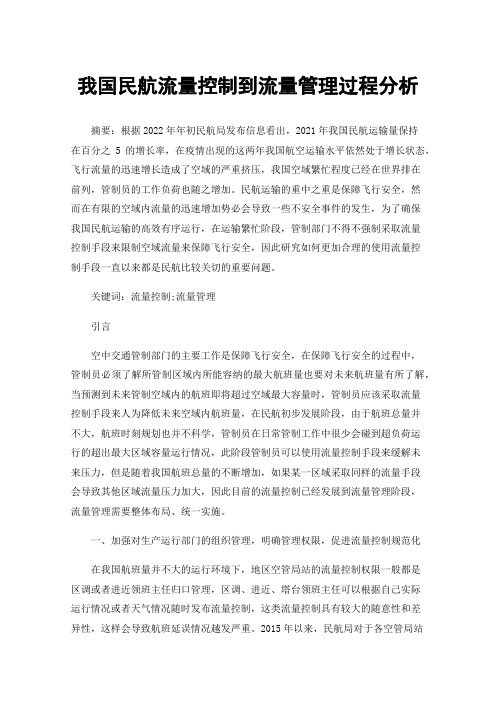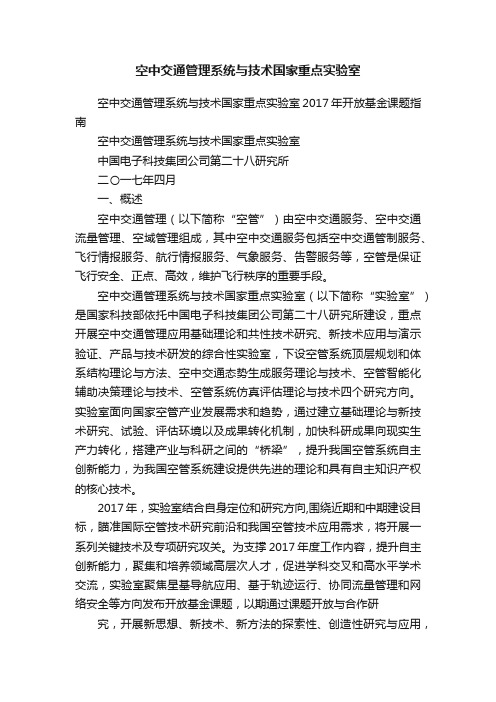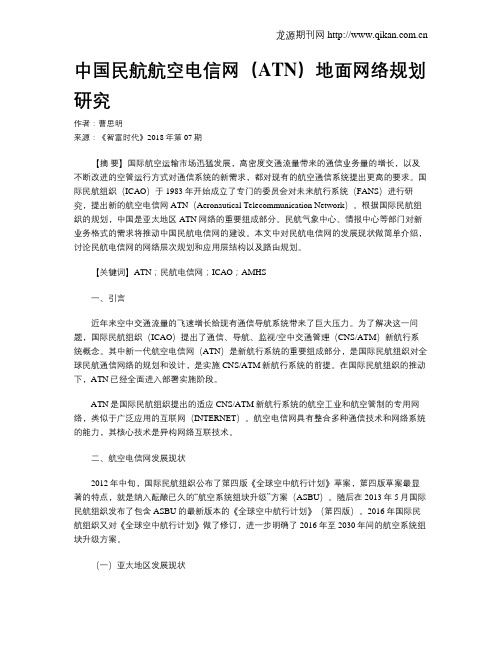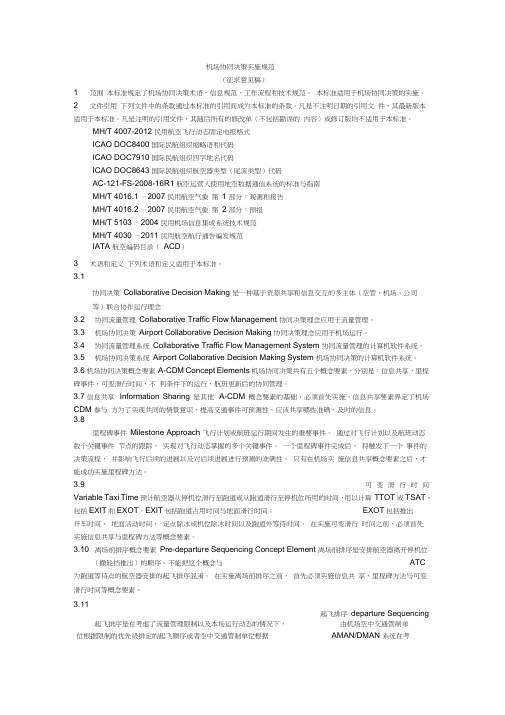国际民航组织亚太地区协同流量管理
基于性能的导航(PBN)是国际民航组织(ICAO)在整合各国区...

序基于性能的导航(PBN)是国际民航组织(ICAO)在整合各国区域导航(RNA V)和所需导航性能(RNP)运行实践和技术标准的基础上,提出的一种新型运行概念。
它将飞机先进的机载设备与卫星导航及其他先进技术结合起来,涵盖了从航路、终端区到进近着陆的所有飞行阶段,提供了更加精确、安全的飞行方法和更加高效的空中交通管理模式。
PBN是飞行运行方式的重大变革,能有效促进民航持续安全,增加空域容量,减少地面导航设施投入,提高节能减排效果,是我国从航空大国向航空强国迈进,建设新一代航空运输系统的核心技术之一。
中国民航局决定按照ICAO的有关要求和亚太地区实施规划,加快这项技术的应用,组织全面实施。
本路线图结合我国实际情况,明确了中国民航从当前到2025年期间实施PBN的政策和总体工作计划,为各利益相关方提供指南,促进全球标准统一和国际合作。
希望有关各方在该路线图的具体实施过程中,提出修正意见,使之不断更新完善,适应中国民航快速发展的需求,并成为中国民航航行新技术发展的标志性规划和国际航空界的蓝图范本。
民航局PBN实施领导小组组长目录1. 背景..................................................................................................................................- 1 -1.1 PBN概念..................................................................................................................- 1 -1.2 作用及优势.............................................................................................................- 2 -1.3 ICAO要求................................................................................................................- 2 -2. PBN实施路线图目的.......................................................................................................- 3 -2.1 明确决策和计划.....................................................................................................- 3 -2.2 帮助沟通和理解.....................................................................................................- 3 -2.3 确立职责和分工.....................................................................................................- 3 -3. 中国民航运输系统..........................................................................................................- 4 -3.1 现状.........................................................................................................................- 4 -3.2 挑战.........................................................................................................................- 4 -3.3 未来发展.................................................................................................................- 6 -4. 实施具体工作..................................................................................................................- 7 -4.1 总体目标.................................................................................................................- 7 -4.2 关键任务.................................................................................................................- 7 -4.2.1 规章标准的制定...........................................................................................- 7 -4.2.2 航路规划和飞行程序设计...........................................................................- 7 -4.2.3 航空运营人运行能力的建立.......................................................................- 8 -4.2.4 宣传与培训...................................................................................................- 8 -4.2.5 国际协调.......................................................................................................- 8 -5. 实施时间表......................................................................................................................- 9 -5.1 近期(2009-2012).............................................................................................- 9 -5.2 中期(2013-2016)...........................................................................................- 10 -5.3 远期(2017-2025)............................................................................................- 11 -6. 通用航空........................................................................................................................- 12 -6.1 现状.......................................................................................................................- 12 -6.2 发展策略...............................................................................................................- 13 -7. 航空器能力....................................................................................................................- 14 -7.1 现有机队总体情况...............................................................................................- 14 -7.2 机载设备标准.......................................................................................................- 16 -7.3 机队PBN能力现状...............................................................................................- 16 -7.4 机队改装计划.......................................................................................................- 17 -8. 导航基础设施................................................................................................................- 19 -8.1 现状.......................................................................................................................- 19 -8.1.1 传统导航设施.............................................................................................- 19 -8.1.2 GNSS导航设施............................................................................................- 20 -8.2 GNSS未来发展......................................................................................................- 22 -8.2.1“伽利略”卫星导航系统...........................................................................- 22 -8.2.2 GPS现代化...................................................................................................- 22 -8.2.3 GLONASS现代化.......................................................................................- 22 -8.2.4 “北斗”卫星导航系统..................................................................................- 23 -8.3 导航设施规划策略...............................................................................................- 24 -8.3.1 过渡计划.....................................................................................................- 24 -8.3.2 地基导航设施.............................................................................................- 24 -8.3.3 GNSS导航设施............................................................................................- 24 -9. 安全实施原则................................................................................................................- 25 -10. PBN与其他技术的融合及展望...................................................................................- 26 -10.1 通信技术.............................................................................................................- 26 -10.2 监视技术.............................................................................................................- 26 -10.3 其他进近着陆能力.............................................................................................- 27 -10.3.1 “北斗”终端导航........................................................................................- 27 -10.3.2 有垂直引导的进近(APV)........................................................................- 27 -10.3.3 GBAS着陆系统(GLS)..........................................................................- 27 -11. 路线图的修订..............................................................................................................- 29 - 附件A-PBN导航规范简介..............................................................................................- 30 - 附件B-PBN整体规章标准框架......................................................................................- 32 - 附件C-国际PBN实施整体概况......................................................................................- 33 - 附件D-术语......................................................................................................................- 35 - 致谢.....................................................................................................................................- 38 -1. 背景1.1 PBN概念在航空飞行中,传统导航是利用接收地面导航台信号,通过向台和背台飞行实现对航空器的引导,航路划设和终端区飞行程序受地面导航台布局与设备种类的制约。
基础知识1.8空域

1.8空域1 在我国现行的空域中,空域分为()、管制区、()、危险区、禁区、航路和()A:飞行情报区、限制区、航线B:航空管制区、放油区、等待区C:进近管制区、放油区、航线D:飞行情报区、放油区、等待区A2 对于各类空域的划分,应当符合()的结构、()的布局、飞行活动的性质和供()的需要。
A:航路、机场、空中交通管制B:空域、航线、空中交通情报C:航路、扇区、空中交通情报D:空域、机场、空中交通管制A3 管制空域应当根据所划空域内的()和通信、导航、气象、()能力划分,以便对所划空域内的航空器飞行提供有效的空中交通管制服务。
A:航路结构、监视B:机场布局、分析C:飞行流量、服务D:航路结构、管制员A4 我国D类空域的下限为();A、B、C、D类空域的上限,应当根据提供空中交通管制的情况确定,如无上限,应当与()上限一致。
A:地球表面、巡航高度层B:最低安全高度、l3000mC:地球表面、l3000mD:最低安全高度、巡航高度层A5 在我国境内()m(含)以上的空间,划分为若干个高空管制空域,在此空域内飞行的航空器必须按照()飞行并接受空中交通管制服务A:6000、仪表飞行规则B:6600、仪表飞行规则C:6600、目视飞行规则D:6000、固定航路B6 在我国境内6600m(不含)以下()以上的空间,划分为若干个中低空管制空域,在此空域内飞行的航空器,可以按照()飞行。
A:最低高度层、仪表B:地球表面、仪表C:最低安全高度、雷达D:最低安全高度、仪表A7 C类空域指()A:中低空管制区B:中低空管制空域与塔台管制空域之间的连接部分,其垂直范围通常在6600m(含)以下最低高度层以上C:在一个或几个机场附近的航路汇合处划设的便于进场和离场航空器飞行的管制空域D:在此空域内飞行的航空器,只能按照仪表飞行规则飞行C8 D类空域为()管制空域,通常包括起落航线、()(含)及其以下地球表面上的空间和机场机动区A:塔台、第一等待高度层B:进近、空中走廊C:塔台、空中走廊D:进近、过渡高度层A9 航路,()和民用机场区域设置高空管制区、中低空管制区,终端(进近)管制区和机场塔台管制区。
4.5空域管理和流量管理

地球表面上空某一规定界限向上延伸
管制地带
地球表面向上延伸到规定界限
2003年3月 空中交通管理基础 11
我国管制空域
A类 高空管制区 6600米(含)以上 IFR
B类 中低空管制区 6600(不含)米以下 IFR/VFR
C类 终端管制区(进近管制区)IFR/VFR
D类 机场管制地带 IFR/VFR
空中交通管理基础 51
通信、导航、雷达设施故障
预计扇区或区域流量超过负荷由有关ACC向管调报告
2003年3月
流量管理的权限—单位
ACC
有权限制本管制区内各机场的起飞时刻 有权就即将飞进本管制区的航空器提出限制条件 有权增开扇区 有权就即将飞进本管制区的航空器提出限制条件 有权增开扇区 有权限制航空器在本场着陆的时刻 有权限制航空器的开车和起飞时刻
流量管理的分类
先期流量管理
不迟于飞行前一日进行
飞行前流量管理
航空器开车、起飞前
实时流量管理
飞行过程中
空中交通管理基础 45
2003年3月
流量管理的原则
以先期流量管理和飞行前流量管理为主, 实时流量管理为辅
飞行前采取措施为主,飞行中采取措施为
辅
航空器地面等待为主,航空器空中等待为
辅
2003年3月
2003年3月 空中交通管理基础 40
流量管理
机构及职能 流量管理的分类 流量管理的原则 流量管理的依据 容量规定 流量管理的方法 流量管理的权限
2003年3月 空中交通管理基础 41
我国现行流量管理机构
总调
地区管理局空管局
塔台
我国民航流量控制到流量管理过程分析

我国民航流量控制到流量管理过程分析摘要:根据2022年年初民航局发布信息看出,2021年我国民航运输量保持在百分之5的增长率,在疫情出现的这两年我国航空运输水平依然处于增长状态,飞行流量的迅速增长造成了空域的严重挤压,我国空域繁忙程度已经在世界排在前列,管制员的工作负荷也随之增加。
民航运输的重中之重是保障飞行安全,然而在有限的空域内流量的迅速增加势必会导致一些不安全事件的发生,为了确保我国民航运输的高效有序运行,在运输繁忙阶段,管制部门不得不强制采取流量控制手段来限制空域流量来保障飞行安全,因此研究如何更加合理的使用流量控制手段一直以来都是民航比较关切的重要问题。
关键词:流量控制;流量管理引言空中交通管制部门的主要工作是保障飞行安全,在保障飞行安全的过程中,管制员必须了解所管制区域内所能容纳的最大航班量也要对未来航班量有所了解,当预测到未来管制空域内的航班即将超过空域最大容量时,管制员应该采取流量控制手段来人为降低未来空域内航班量,在民航初步发展阶段,由于航班总量并不大,航班时刻规划也并不科学,管制员在日常管制工作中很少会碰到超负荷运行的超出最大区域容量运行情况,此阶段管制员可以使用流量控制手段来缓解未来压力,但是随着我国航班总量的不断增加,如果某一区域采取同样的流量手段会导致其他区域流量压力加大,因此目前的流量控制已经发展到流量管理阶段,流量管理需要整体布局、统一实施。
一、加强对生产运行部门的组织管理,明确管理权限,促进流量控制规范化在我国航班量并不大的运行环境下,地区空管局站的流量控制权限一般都是区调或者进近领班主任归口管理,区调、进近、塔台领班主任可以根据自己实际运行情况或者天气情况随时发布流量控制,这类流量控制具有较大的随意性和差异性,这样会导致航班延误情况越发严重。
2015年以来,民航局对于各空管局站发布的流量控制要求越来越严格,各地如果发布了一定的流控,需要向上级部门汇报留空理由,当流控程度达到一定的程度甚至会启动调查程序,经过多年运行,空管单位目前发布流量控制的方式和程度已经越来越规范。
智慧空管技术的进展

智慧空管技术的进展中国民航空管改革的总目标是建设“四强空管(强安全、强效率、强智慧、强协同)”,智慧空管是四强空管中重要的一环,可以分为“智慧运行、智慧服务、智慧设施、智慧管理”四个层面。
近年来,民航局和空管局对智慧空管进行了顶层设计,在推动和建设智慧空管的实际工作中,也取得了大量成果。
本文以智慧运行与智慧设施为出发点,探讨技术体系层面上的共识,结合其他国家和组织对下一代空管系统的研究,对智慧空管的技术体系、实现智慧空管所需的基础设施,作出思考。
打破“数据孤岛”要实现智慧空管,首先要实现空管的数字化转型。
通过持续创新来适应数字化时代,是建设现代化空管技术体系的有效途径。
空管数字化是基于当前强大的信息化技术所提供的支持和能力,让空管业务和信息技术真正产生交互,即在大数据、人工智能、云计算、物联网等信息技术的支持下,为空管业务的达成,提供更高效的途径。
空管数字化转型的基础是空管生产工具的信息化改造。
在信息化改造完成之后,由于有大数据、人工智能等越来越强大算力的支持,空管决策方式和决策能力都将会获得极大的改变和提升。
当然,空管生产工具的数字化并不是一个需要完全从头开始的工作。
近年来,塔台管制员的视觉观察及地空语音通信已经在一定程度上实现了“数据化”。
不过,空管的大部分设备及系统是独立运行的,设备及系统之间不能实现高效的信息交互。
例如,针对同一个航班,不同的自动化系统会独立进行航迹推算,产生的飞行数据自然就各有差异。
目前,行业内已经充分认识到这种“数据孤岛”的现状,在西北空管局和华东空管局“数字化转型”的前期工作中,以及中国民航局空管局大数据平台研究中,数据治理,或者说是空管生产数据信息标准研究都是第一位的工作。
相关信息显示,空管生产数据信息标准第一稿已经编写完成。
以云平台为基础的服务笔者认为,智慧空管的基础设施,是以云化“广域信息管理(SWIM)”服务为核心,基于高速发展的大数据云服务(例如华为云或者阿里云提供的从数据分析到语音、图像识别,到人工智能服务),通过逐渐完善中的“空管生产数据信息标准”和其他国际标准,连接空管现有生产运行系统的体系。
(中文版)国际民航组织空中航行报告2014年版 ICAO-Air Navigation Report-2014

在非洲和印度洋地区实施 80 条基于性能导航的 用户优选航迹线 .......................................................... 45 亚洲和南太平洋减排举措(ASPIRE 项目) ................... 45 协作性的环境举措(印度洋减排战略伙伴关系项目) ... 46 空中交通服务设施间数据通信(AIDC) 在加勒比和北美地区的实施情况 .................................. 46 菲律宾飞行情报区的商业案例...................................... 47 阿联酋在运用灵活使用空域(FUA)方面的经验............ 47 区域导航、空域改进使得容量增加(阿联酋).............. 49 国际民航组织与业界和其他标准制定机构的伙伴关系 ... 49
目录
目录
执行摘要
业务概述....................................................................... 5 系统概述....................................................................... 6 国际民航组织实施支助包............................................... 7
下一步措施
全球空中航行报告一瞥 ................................................ 50 《全球空中航行报告》今后的一些步骤........................ 52
பைடு நூலகம்
空中交通管理系统与技术国家重点实验室

空中交通管理系统与技术国家重点实验室空中交通管理系统与技术国家重点实验室2017年开放基金课题指南空中交通管理系统与技术国家重点实验室中国电子科技集团公司第二十八研究所二〇一七年四月一、概述空中交通管理(以下简称“空管”)由空中交通服务、空中交通流量管理、空域管理组成,其中空中交通服务包括空中交通管制服务、飞行情报服务、航行情报服务、气象服务、告警服务等,空管是保证飞行安全、正点、高效,维护飞行秩序的重要手段。
空中交通管理系统与技术国家重点实验室(以下简称“实验室”)是国家科技部依托中国电子科技集团公司第二十八研究所建设,重点开展空中交通管理应用基础理论和共性技术研究、新技术应用与演示验证、产品与技术研发的综合性实验室,下设空管系统顶层规划和体系结构理论与方法、空中交通态势生成服务理论与技术、空管智能化辅助决策理论与技术、空管系统仿真评估理论与技术四个研究方向。
实验室面向国家空管产业发展需求和趋势,通过建立基础理论与新技术研究、试验、评估环境以及成果转化机制,加快科研成果向现实生产力转化,搭建产业与科研之间的“桥梁”,提升我国空管系统自主创新能力,为我国空管系统建设提供先进的理论和具有自主知识产权的核心技术。
2017年,实验室结合自身定位和研究方向,围绕近期和中期建设目标,瞄准国际空管技术研究前沿和我国空管技术应用需求,将开展一系列关键技术及专项研究攻关。
为支撑2017年度工作内容,提升自主创新能力,聚集和培养领域高层次人才,促进学科交叉和高水平学术交流,实验室聚焦星基导航应用、基于轨迹运行、协同流量管理和网络安全等方向发布开放基金课题,以期通过课题开放与合作研究,开展新思想、新技术、新方法的探索性、创造性研究与应用,为我国当前和未来新一代空管系统的发展和建设提供可控实用的顶层设计技术与关键性基础技术支撑。
二、国内外研究情况2003年,国际民航组织第11次航行大会提出并正式通过了全球空管一体化运行概念,其中包含空域组织与管理、需求与容量平衡、机场运行、交通同步、冲突管理、空域用户运行和空管服务七个组成部分,核心理念是一体化、互操作、无缝、全系统信息管理和协同决策,旨在指导CNS/ATM技术的实施,满足高度发达国家和地区的航空发展需求。
中国民用航空安全规划纲要-中国民用航空局

中国民⽤航空安全规划纲要-中国民⽤航空局中国民⽤航空安全规划纲要(2011-2020年)中国民⽤航空局2011年8⽉⽬录前⾔ (1)⼀、中国民航安全⼯作回顾与展望 (2)(⼀)安全⼯作回顾 (2)(⼆)未来⼗年展望 (3)⼆、安全⼯作⽬标 (6)(⼀)降低重⼤事故率 (6)(⼆)提升系统能⼒ (7)三、政策和措施 (7)(⼀)完善⾏业安全体系 (7)(⼆)建设积极的安全⽂化 (8)(三)推进安全科技进步 (8)(四)加强专业⼈员教育培训 (8)(五)加强安全保障设施建设 (9)(六)加强适航管理能⼒ (9)(七)加强国际交流与合作 (9)附件1 纲要附图 (11)前⾔安全是社会⽂明和进步的重要标志,也是整个⾏业赖以⽣存、发展的重要基础。
过去⼗年,中国民航的安全⽔平不断提⾼。
2001-2005年,中国民航运输航空重⼤及以上事故率为0.19次/百万飞⾏⼩时,2006-2010年下降到0.05次/百万飞⾏⼩时,安全⽔平步⼊世界先进⾏列,实现了《中国民⽤航空安全规划纲要(2001-2010年)》提出的“在2001-2005年期间,每百万飞⾏⼩时重⼤事故率低于0.74;在2006-2010年期间达到每百万飞⾏⼩时重⼤事故率低于0.3”的安全⽬标。
但是从总体上看,中国民航的安全基础仍相对薄弱,⾏业安全体系正在完善之中,安全综合保障能⼒与⾏业快速发展还不相适应,与航空发达国家相⽐还有很⼤差距。
为了在未来⼗年进⼀步提⾼我国民航的安全⽔平,还需要创新安全管理理念,制定适合中国民航实际的安全⽬标,进⼀步完善⾏业安全体系及其运⾏机制,提升安全管理⽔平。
因此,围绕民航强国⽬标,按照“安全第⼀、预防为主、综合治理”的⽅针,制定本规划纲要,指导未来⼗年中国民航安全⽣产⼯作。
⼀、中国民航安全⼯作回顾与展望(⼀)安全⼯作回顾六⼗年来,中国民航的安全⽔平不断提⾼,事故率总体呈现下降趋势,特别是近⼗年来,有较⼤幅度的降低。
2001-2010年,中国民航运输航空重⼤及以上事故率为0.10次/百万飞⾏⼩时,0.19次/百万架次。
中国民用航空局、国家发展和改革委员会关于推进国际航空枢纽建设的指导意见

中国民用航空局、国家发展和改革委员会关于推进国际航空枢纽建设的指导意见文章属性•【制定机关】中国民用航空局,国家发展和改革委员会•【公布日期】2024.07.31•【文号】民航发〔2024〕28号•【施行日期】2024.07.31•【效力等级】部门规范性文件•【时效性】现行有效•【主题分类】民航正文中国民用航空局国家发展和改革委员会关于推进国际航空枢纽建设的指导意见民航发〔2024〕28号民航各地区管理局、各运输(通用)航空公司、各服务保障公司、各机场公司、民航局属各单位,各省、自治区、直辖市及新疆生产建设兵团发展改革委:国际航空枢纽是航空运输服务体系的核心节点,是现代综合交通运输体系的重要组成,是民航服务国家对外开放和构建新发展格局的重要支撑,对服务国家重大战略实施、服务区域经济社会发展、服务人民群众便捷高效航空出行具有重要作用。
为解决我国国际航空枢纽战略谋划不深、枢纽竞争力不强、协同运行效率不高、国际运输服务能力不足等问题,高水平建设国际航空枢纽,提升民航国际竞争力,更好发挥民航国家重要战略产业作用,提出以下意见。
一、总体要求以习近平新时代中国特色社会主义思想为指导,深入贯彻党的二十大和二十届二中、三中全会精神,完整、准确、全面贯彻新发展理念,着力推动民航高质量发展,服务构建新发展格局。
牢牢把握国家对特定地区的战略定位,落实国家区域重大战略和区域协调发展战略,打造定位清晰、各具特色、竞争力强的航空枢纽功能体系。
以推进一批夯基础、强功能、利长远的重大规划、重点工程、重要政策实施为抓手,以推动国际航空枢纽顶层设计更加完善、规划建设更加优化、运行管理更加协同、运输服务更加高效为重点任务,推动国际航空枢纽资源优化配置,打造2-3家世界级超级航空承运人,强化北京、上海、广州等国际航空枢纽全方位门户复合型功能,打造一批面向特定区域的国际航空枢纽和区域航空枢纽,为更好推动国家重大战略实施,服务高水平对外开放,满足人民美好航空出行需求,加快谱写交通强国建设民航新篇章提供有力支撑。
中国民航航空电信网(ATN)地面网络规划研究

中国民航航空电信网(ATN)地面网络规划研究作者:曹思明来源:《智富时代》2018年第07期【摘要】国际航空运输市场迅猛发展,高密度交通流量带来的通信业务量的增长,以及不断改进的空管运行方式对通信系统的新需求,都对现有的航空通信系统提出更高的要求。
国际民航组织(ICAO)于1983年开始成立了专门的委员会对未来航行系统(FANS)进行研究,提出新的航空电信网ATN(Aeronautical Telecommunication Network)。
根据国际民航组织的规划,中国是亚太地区ATN网络的重要组成部分。
民航气象中心、情报中心等部门对新业务格式的需求将推动中国民航电信网的建设。
本文中对民航电信网的发展现状做简单介绍,讨论民航电信网的网络层次规划和应用层结构以及路由规划。
【关键词】ATN;民航电信网;ICAO;AMHS一、引言近年来空中交通流量的飞速增长给现有通信导航系统带来了巨大压力。
为了解决这一问题,国际民航组织(ICAO)提出了通信、导航、监视/空中交通管理(CNS/ATM)新航行系统概念。
其中新一代航空电信网(ATN)是新航行系统的重要组成部分,是国际民航组织对全球民航通信网络的规划和设计,是实施CNS/ATM新航行系统的前提。
在国际民航组织的推动下,ATN已经全面进入部署实施阶段。
ATN是国际民航组织提出的适应CNS/ATM新航行系统的航空工业和航空管制的专用网络,类似于广泛应用的互联网(INTERNET)。
航空电信网具有整合多种通信技术和网络系统的能力,其核心技术是异构网络互联技术。
二、航空电信网发展现状2012年中旬,国际民航组织公布了第四版《全球空中航行计划》草案,第四版草案最显著的特点,就是纳入酝酿已久的“航空系统组块升级”方案(ASBU)。
随后在2013年5月国际民航组织发布了包含ASBU的最新版本的《全球空中航行计划》(第四版)。
2016年国际民航组织又对《全球空中航行计划》做了修订,进一步明确了2016年至2030年间的航空系统组块升级方案。
民用航空使用空域工作程序

中国民用航空总局空中交通管理局编号:AP-71TM-74部门代号:TM日期:2004年6月11日民用航空使用空域工作程序《民用航空使用空域工作程序》已经2004年6月7日民航总局空中交通管理局局长办公会议通过,现予公布,自2004年6月26日起施行。
二○○四年六月十一日目录第一章 总 则 (3)第二章 空域使用基本工作程序 (3)第三章 飞行情报区和管制区 (5)第一节 飞行情报区 (5)第二节 高空和中低空管制区 (6)第三节 终端和进近管制区 (7)第四节 机场管制地带和塔台管制区 (9)第五节 管制扇区 (9)第四章 航路、航线和进离场航线 (10)第一节 一般规定 (10)第二节 航路和航线 (12)第三节 进离场航线 (13)第四节 等待航线 (14)第五章 其他空域 (14)第一节 空中禁区、限制区和危险区 (14)第二节 空中放油区 (15)第三节 临时飞行空域 (16)第六章 重要点的设置 (17)第七章 新建改建和扩建机场涉及的空域调整 (18)第八章 导航设施建设涉及的空域调整 (20)第九章 空域数据管理 (20)第十章 附 则 (21)附件一 空域使用基本工作程序图示 (22)附件二 空域数据标准表格 (23)民用航空使用空域工作程序第一章总则第一条为规范民用航空相关空域的建设和使用,明确空域建设和使用工作的职责和程序,根据《民用航空使用空域办法》以及有关规定,制定本程序。
第二条本程序适用于根据国家规定建设和使用相关空域的活动。
民用航空空中交通管理机构和从事民用航空活动的单位和个人,应当遵守本程序的相关规定。
第三条中国民用航空总局(以下简称民航总局)空中交通管理局负责提出民用航空对空域的需求、建设和使用意见,按照国家规定组织相关空域的建设和使用,监督和检查民用航空活动使用空域的情况。
民航地区空中交通管理局负责监督本地区民用航空活动使用空域的情况,协调民用航空活动在空域内的日常运行,提出民用航空活动对空域的需求、建设和使用意见和建议,报民航总局空中交通管理局或者根据本程序的规定协商解决。
民用航空使用空域办法

民 用 航 空 使 用 空 域 办 法(2004年5月26日中国民用航空总局令第122号发布 自2004年6月26日起施行)目 录第一章 总则 (1)第二章 空域分类 (3)第三章 空中交通服务区域 (6)第四章 空域规范 (9)第五章 空域数据 (28)第六章 空域使用程序 (30)第七章 附则 (34)附件一:定义 (35)附件二:各类空域对空中交通服务和飞行的要求 (41)附件三:导航容差和缓冲区 (43)附件四:管制扇区划设指导材料 (50)附件五:重要点的设置和识别规范 (54)附件六:航路和航线代号的识别规范 (62)附件七:空中禁区、限制区和危险区代号的识别规范 (70)附件八:航行数据质量要求 (72)第一章总则第一条 为了规范民用航空活动相关空域的建设和使用,保证航空器运行的安全和效率,充分开发和合理使用空域资源,根据《中华人民共和国飞行基本规则》以及有关规定,制定本办法。
第二条 本办法适用于在中华人民共和国领空以及根据我国缔结或者参加的国际条约的规定,由我国提供空中交通服务的公海上空的民用航空相关空域的建设和使用活动。
民用航空管理部门、空中交通服务机构和从事民用航空活动的单位和个人,应当遵守本办法的相关规定。
第三条 空域是国家资源,应当得到合理、充分和有效的利用。
空域的建设和使用应当遵循下列基本原则:(一)保证飞行安全。
空域的建设和使用应当有利于防止航空器与航空器、航空器与障碍物之间相撞,有利于航空器驾驶员处置遇险等紧急情况。
(二)保证国家安全。
空域的建设和使用应当适应国土防空和国家安全的要求。
(三)提高经济效益。
空域的建设和使用应当对国家经济建设产生有利的影响和作用,应当有利于航空企业降低运营成本。
(四)便于提供空中交通服务。
空域的建设和使用应当便于空中交通服务部门向运行中的航空器提供空中交通服务,满足空中交通服务对空域使用的需要。
(五)加速飞行活动流量。
空域的建设和使用应当有利于维护并加速空中交通的有序活动。
空管自动化系统AIDC报文处理逻辑

空管⾃动化系统AIDC报⽂处理逻辑2019-10-30摘要随着民航事业的发展,不同的管制单位的管制设备之间数据交换产⽣了全新的⽅式,即AIDC。
⽂章主要介绍AIDC设计需求以及AIDC报⽂处理逻辑,针对实际⼯作中产⽣的问题进⾏分析。
关键词 AIDC;AIDC报⽂;管制移交中图分类号:TN917 ⽂献标识码:A ⽂章编号:1671-7597(2013)19-0043-011 AIDC概念AIDC是Air Traffic Services Interfaci1ity Data Communications的缩写,即空中交通服务设施间的数据通信,通常说的电⼦移交。
AIDC是为了减少电话移交和协调,使协调位管制员能更有效、及时地对席位管制员的管制指挥⼯作实施监控⽽引⼊的航空⾃动化管理技术。
AIDC(ATS INTER—FACILITYGROUND/GROUND CO ICATION)是国际民航组织在亚太地区推荐使⽤的空管⾃动化系统管制⾃动移交协议,其可以完全取代当前地⾯电话协调移交,独⽴完成移交过程,在配备了具有AIDC功能的⾃动化系统间利⽤AIDC进⾏屏幕电⼦移交,可以充分利⽤系统⾃动处理能⼒,降低电话协调的使⽤,减少管制员的协调⼯作量和出差错概率,使其将精⼒集中于屏幕监控和调配飞⾏冲突。
由于AIDC协议为ICA0统⼀标准,因此可以在不同的航管⾃动化系统间推⾏。
在飞⾏流量⽇益增加、相邻管制区间协调移交任务⽇益繁重的今天,AIDC将是解决此瓶颈问题的重要技术⼿段之⼀,对保障飞⾏安全、顺畅有积极作⽤。
2 AIDC报处理逻辑2.1 预计边界点信息报ABI(Advance Boundary Information)如果航班存在:1)回复LAM报。
2)如果参数PmtRecvABI=1且该份AIDC报为接收到的电报提⽰FDD收到⼀份ABI报。
3)如果是进港或飞越的航班,航班还处在准备、未激活状态,则航班进⼊起飞状态。
中国民用航空局公布《民用航空协同运行管理办法》

中国民用航空局公布《民用航空协同运行管理办法》文章属性•【制定机关】中国民用航空局•【公布日期】2024.04.17•【文号】民航规〔2024〕32号•【施行日期】2024.06.01•【效力等级】部门规范性文件•【时效性】现行有效•【主题分类】民航正文民用航空协同运行管理办法目录第一章总则第二章机构和职责第三章运行规划阶段第四章运行准备阶段第五章运行实施阶段第六章运行后分析阶段第七章监督管理第八章附则第一章总则第一条为规范民用航空协同运行工作,保障飞行安全,改善服务品质,提升航班运行效率,依据《中华人民共和国民用航空法》《中华人民共和国飞行基本规则》《民用机场管理条例》《航班正常管理规定》《中国民用航空应急管理规定》《民用航空空中交通管理规则》等法律、行政法规和规章,制定本办法。
第二条本办法适用于民用航空协同运行工作的管理,包括重大航空运输活动运行保障、预先飞行计划编排、日常运行协调、大面积航班延误和运行不正常情况的应急处置、运行后复盘等。
第三条本办法所称的民用航空协同运行是指为保障航班安全、高效、顺畅运行,在公共航空运输企业(以下简称航空公司)、机场管理机构、空中交通管理单位(以下简称空管单位)等运行单位间建立工作程序、搭建系统平台、共享运行数据,构建协商决策、联动落实、动态管理的工作机制。
民用航空协同运行按照不同阶段划分,分为运行规划阶段、运行准备阶段、运行实施阶段和运行后分析阶段。
第二章机构和职责第四条中国民用航空局(以下简称民航局)负责全国民用航空协同运行的统一监督管理工作,制定管理办法和工作程序,中国民用航空地区管理局(以下简称地区管理局)负责辖区内民用航空协同运行的监督管理工作。
第五条民航局运行监控中心(以下简称运行监控中心)负责组织全国民用航空协同运行工作,指导航空公司、机场管理机构、空管单位等运行主体协同运行工作的具体实施,推动各运行主体之间建立协同运行机制,构建运行主体之间的协同平台。
空中交通管理-空域管理和流量管理

(4)航路和航线
(1)航路 为了保证飞行安全和效率,空域管理机构为飞行密集 的航线划设具有一定宽度的保护区,并配备必要的导航设 备,为在该航线上航行的航空器提供准确、连续和可靠的 引导,保证航空器偏出保护区之外的概率在既定的安全目 标值之下,这种以走廊形式划设的配备无线电导航设备的 管制区或其一部分称为航路。
(1)飞行情报区
香港飞 行情报 区
我国飞行情报区
飞行情报区 内的飞行情 报工作由该 区飞行情报 部门承担或 由指定的单 位负责,如 区域管制中 心。
(2)管制区
国际上按照是否提供空中交通管制服务把空域分成管制空 域和非管制空域。
国际民航组织(ICAO)把管制空域分为:A、B、C、D、E 类;把非管制空域分为:F、G类。
需要空中交通流量管理ATFM(Air Traffic Flow Management)
1.ATFM的定义和目的
一般来讲,ATFM是指科学地安排空中交通量,即充分 利用空中交通管制系统的可用容量,使得空中交通安全、 高效、有序,提高资源的利用率。 目的是当某个时间空中交通管制系统的飞行流量超出 或者将要超出其能力时,采取必要的措施,进行调节,保 证空中交通量最佳的流入或通过相应的空域,达到对机场 和空域容量的最大利用率。
缩小垂直间隔 Reduced Vertical Separation Minimum RVSM 缩小水平间隔 区域导航 Regional Navigation RNAV 实施雷达管制 空域安全性和容量评估
缩小垂直间隔
二、空中交通流量管理
Over 5,000 aircraft operating at the same time in the U.S.
主干航路网络规划方法

主干航路网络规划方法戴福青;万小艳【摘要】为了提高全国民航可用空域的利用率和运行效能,针对民航运输的特点,通过建立城市民航运输综合实力评价指标体系和阻抗函数对引力模型进行改进.应用改进的引力模型构建我国主干航路网络系统,并根据我国的城市地理分布对航路网结构进行优化调整.最后通过与现行网络的性能指标对比,证明利用改进引力模型构建和优化的航路网方案的网络安全性、网络总长度、航路利用率、网络连接度等指标都明显优于现行网络.【期刊名称】《科学技术与工程》【年(卷),期】2014(014)003【总页数】6页(P271-276)【关键词】空域规划;主干航路网络;引力场模型;评价指标体系;主成分分析法;网络优化【作者】戴福青;万小艳【作者单位】中国民航大学空中交通管理学院,天津300300;中国民航大学空中交通管理学院,天津300300【正文语种】中文【中图分类】V355.2改革开放后,我国民航业得到了迅速发展。
目前,我国已经建立了主干航路、区域干线和支线三个层次的航路网,国际航路辐射北美和欧洲、日韩和东南亚等主要地区,国内干线航路贯通几大枢纽机场,国内支线航路联通各地区。
其中主干航路网在整个航路网络中起着举足轻重的作用,以30%的航段距离承担了65%的流量,然而随着航空运输行业的飞速发展,空中交通流量的迅速增长,现行的航路网络布局也逐步暴露出其结构性缺陷:结构单一,航路容量极易饱和,部分重要交通流向间未设直通航路。
因此从网络优化设计方面对我国主干航路网进行全局规划,以解决我国航路网络存在的问题具有极大的现实意义。
对于航路网络规划的重视应追溯到20世纪80年代。
80年代末期,欧洲航空导航规划组织开始提出ARN干线航路网络规划计划,到2004年,设计了覆盖欧洲的航路主干网络[1];2001年,美国联邦航空局启动了国家空域重组计划(NAR)[2]。
1993年澳大利亚民航当局制定了十四条“航路建设原则”,由于其科学性和合理性,国际民航组织亚太地区航行规划和实施小组将该原则作为建设航路的指导原则。
机场协同决策实施规范.docx

机场协同决策实施规范(征求意见稿)1 范围本标准规定了机场协同决策术语,信息规范,工作流程和技术规范。
本标准适用于机场协同决策的实施。
2 文件引用下列文件中的条款通过本标准的引用而成为本标准的条款。
凡是不注明日期的引用文件,其最新版本适用于本标准。
凡是注明的引用文件,其随后所有的修改单〈不包括勘误的内容〉或修订版均不适用于本标准。
MH/T 4007-2012 民用航空飞行动态固定电报格式ICAO DOC8400 国际民航组织缩略语和代码ICAO DOC7910 国际民航组织四字地名代码ICAO DOC8643 国际民航组织航空器类型(尾流类型)代码AC-121-FS-2008-16R1 航空运营人使用地空数据通信系统的标准与指南MH/T 4016.1 -2007 民用航空气象第1 部分:观测和报告MH/T 4016.2 -2007 民用航空气象第2 部分:预报MH/T 5103 -2004 民用机场信息集成系统技术规范MH/T 4030 -2011 民用航空航行通告编发规范IATA 航空编码目录(ACD)3 术语和定义下列术语和定义适用于本标准。
3.1协同决策Collaborative Decision Making 是一种基于资源共享和信息交互的多主体(空管、机场、公司等)联合协作运行理念3.2 协同流量管理Collaborative Traffic Flow Management 协同决策理念应用于流量管理。
3.3 机场协同决策Airport Collaborative Decision Making 协同决策理念应用于机场运行。
3.4 协同流量管理系统Collaborative Traffic Flow Management System 协同流量管理的计算机软件系统。
3.5 机场协同决策系统Airport Collaborative Decision Making System 机场协同决策的计算机软件系统。
空中交通流量管理的技术

04
CHAPTER
空中交通流量管理技术的实践应用
优化航班排序、提高跑道效率、减少等待时间
总结词
大型国际机场通常拥有多个跑道和大量等待起飞的航班。通过空中交通流量管理技术,可以优化航班排序,确保起飞和降落的航班时间间隔合理,提高跑道效率,减少等待时间,从而提升整体运营效率。
总结词:高效实时
详细描述:通信技术是空中交通流量管理的基础之一,通过高效实时的通信网络,能够实现地面控制中心与空中飞行器之间的实时语音和数据传输,从而对飞行器进行精确的指挥和控制。
总结词:精确可靠
详细描述:导航技术为空中交通流量管理提供了关键的支持。现代导航技术包括卫星导航、惯性导航和组合导航等,能够为飞行器提供精确可靠的位置和速度信息,帮助飞行器实现自主导航和精确的航行。
在空中交通流量管理中,安全性始终是最重要的考虑因素。因此,所采用的技术和方法都必须经过严格的验证和测试,以确保系统的安全性和稳定性。
02
CHAPTER
空中交通流量管理的基础技术
总结词:精准可靠
详细描述:雷达探测技术以其高精度、高可靠性的特点,广泛应用于空中交通流量管理。通过地面和机载雷达的协同工作,能够实时获取空中飞行器的位置、速度和高度等信息,为流量管理提供准确的数据支持。
总结词
目前,空中交通流量管理主要依赖于地面雷达和空中交通管制人员的视觉监控,但这种方式的监控范围有限,数据处理能力也受到限制。为了解决这些问题,需要引入更先进的数据处理技术和人工智能算法,提高ATFM系统的自动化程度和监控范围。创新方向包括采用高精度定位技术、多传感器融合技术、大数据分析和机器学习等技术,实现更精准、更高效的空中交通流量管理。
《民航在航路和航线上提供空中交通管制服务的实施办法》

《民航在航路和航线上提供空中交通管制服务的实施办法》第一章总则第一条根据国务院、中央军委空中交通管制委员会颁发的《全国军民航管制区域调整方案》(以下称管制区调整方案)和《全国航路管制指挥移交和航线管制指挥方案》(以下称航路移交方案)的要求,制定本办法。
第二条本办法旨在明确民航对航路上的空中交通实施管制指挥,对航线上的空中交通实施指挥,提供空中交通管制服务的责任范围、服务方式和军民航空中交通管制部门间的工作协调关系和协调办法。
第三条本办法适用于实施“管制区调整方案”和“航路移交方案”所涉及的航路移交民航管制指挥和民航负责航线运行的对空指挥后与飞行组织、飞行实施、飞行保障有关的空中交通管制服务工作。
第二章空域、航路和航线结构第一节航路和航线第四条航路通常分为国际(地区)航路和国内航路。
航路的宽度为20公里,其中心线两侧各10公里;航路的某一段受到条件限制的,可减少宽度,但是不得小于8公里。
沿航路飞行的民航班机通过航路下方军航固定使用区域时,应与军航固定使用区域上限保持规定的安全间隔。
全国航路及其走向参见附件一。
第五条航线通常分为固定航线和临时航线。
航线中心线与航线附近空域之间的侧向安全间隔一般不得小于10公里。
第六条航路、航线上的位置点和管制区交接点由英文五字代码或P字加阿拉伯数字表示。
第七条航路的划设由民航总局提出,报经国务院、中央军委批准;现行航路、航线的对外开放由民航总局提出,报经总参谋部批准;国内跨越飞行管制区的航线的开辟和调整由民航总局提出,报经空军批准;飞行管制区域内的航线的开辟和调整由民航地区管理局提出,报经当地军区空军批准。
第八条国内航路、航线的代号由空军指派;国际航路、航线的代号由民航总局商空军后,与国际民航组织亚太地区办事处协调指派。
第九条航路、航线的数据由民航总局报经有关部门审核后以航行资料汇编的方式对外公布。
第十条民航在航路内提供空中交通管制服务的垂直范围是指地表面至飞行高度层12000米(含)。
- 1、下载文档前请自行甄别文档内容的完整性,平台不提供额外的编辑、内容补充、找答案等附加服务。
- 2、"仅部分预览"的文档,不可在线预览部分如存在完整性等问题,可反馈申请退款(可完整预览的文档不适用该条件!)。
- 3、如文档侵犯您的权益,请联系客服反馈,我们会尽快为您处理(人工客服工作时间:9:00-18:30)。
This Plan was developed by the Asia/Pacific Air Traffic Flow Management Steering Group (ATFM/SG) Approved by APANPIRG/26 and published by the ICAO Asia and Pacific Office, Bangkok
A-1
APANPIRG/26 WP07 Appendix A
CONTENTS
SCOPE OF THE FRAMEWORK .......................................................................................................... 3 DEVELOPMENT AND OBJECTIVES OF THE FRAMEWORK ....................................................... 6 EXECUTIVE SUMMARY ..................................................................................................................... 8 ABBREVIATIONS and ACRONYMS ................................................................................................ 10 BACKGROUND INFORMATION ...................................................................................................... 13 CURRENT SITUATION ...................................................................................................................... 31 PERFORMANCE IMPROVEMENT PLAN ........................................................................................ 42 REGIONAL ATFM CAPABILITY PHASE IA ...................................................................... 43 REGIONAL ATFM CAPABILITY PHASE IB ...................................................................... 45 REGIONAL ATFM CAPABILITY PHASE II........................................................................ 47 RESEARCH AND FUTURE DEVELOPMENT POSSIBILITIES...................................................... 49 MILESTONES, TIMELINES, PRIORITIES AND ACTIONS ............................................................ 51 APPENDIX A: COLLABORATIVE ATFM PRINCIPLES ............................................................... 52 APPENDIX B: CDM/ATFM TRIAL TIERED PARTICIPATION LEVELS .................................... 55 APPENDIX C: ATFM DAILY PLAN SAMPLE TEMPLATE .......................................................... 56 APPENDIX D: ATFM TERMINOLOGY AND COMMUNICATIONS ........................................... 58 APPENDIX E: ATFM TRAINING REQUIREMENTS...................................................................... 64
A-2
APANPIRG/26 WP07 Appendix A SCOPE OF THE FRAMEWORK Regional Air Traffic Flow Management 1.1 The 24th Meeting of the Asia/Pacific Air Navigation Planning and Implementation Regional Group (APANPIRG/24), held in June 2013, considered that with the strong growth of air traffic in the Asia Pacific Region there was a need to effectively manage demand and capacity, particularly at major international air hubs and in the associated major traffic flows (MTF). 1.2 The airspace of the Asia/Pacific Region, particularly that of South East Asia, is characterized by relatively small FIRs with corresponding low flight transit times. Any demand management process applied unilaterally in one FIR had a knock-on effect in multiple ‘downstream’ FIRs, and procedures applied are therefore structured around the lowest capability along any particular route/flow. ‘Flow Management’ in the region has tended to be limited to rudimentary traffic spacing measures imposed by individual FIRs, rather taking a wider network view that optimizes available capacity and manages demand, only when necessary, on a sub-regional basis. 1.3 The Asia/Pacific Seamless ATM Plan provides a blueprint for coordinated Regional development, including capability improvements described in the ICAO Aviation System Block Upgrades (ASBU) roadmap. Air Traffic Flow Management (ATFM) taking a network view, is a key module in ASBU Block Zero. B0-NOPS – Improved Flow Performance through Planning based on a Network-Wide view has since been identified by APANPIRG as one of ten priorities for the Asia/Pacific Region. 1.4 While the concept of a single ATFM entity to serve a region works well in Europe and North America, a centralized ATFM Unit (ATFMU) approach is not yet practicable for the Asia/Pacific region. The need for a regional ATFM framework focusing on sub-regional, multi-State implementation, rather than individual FIR-based programs, was recognized by APANPIRG/24 in its adoption of the following Conclusion: Conclusion 24/15: Asia/Pacific ATFM Steering Group That, States participate in, and support the Asia/Pacific ATFM Steering Group to develop a common Regional ATFM framework, which addresses ATFM implementation and ATFM operational issues in the Asia/Pacific region. 1.5 This document, the Asia/Pacific Region Framework for Collaborative ATFM (the Framework) is intended to provide a common Regional framework that addresses ATFM implementation and ATFM operational issues in the Asia/Pacific region. Further discussed in later sections, a core concept of the Framework is the distributed multi-nodal ATFM network, envisaged as interconnected States and/or sub-Regional groups operating in an ATFM network without the need for any central, physical facility providing the network management function. The concept, untried elsewhere, originated in the Regional ATFM Concept of Operations, developed as a collaborative effort between Singapore and industry partners, later expanded to involve Hong Kong China, Malaysia and Thailand. The Framework will, in its future versions, be expanded and adjusted where necessary as the concept matures and experience is gained from operational implementation of cross-border, network-based ATFM and its supporting technology.
